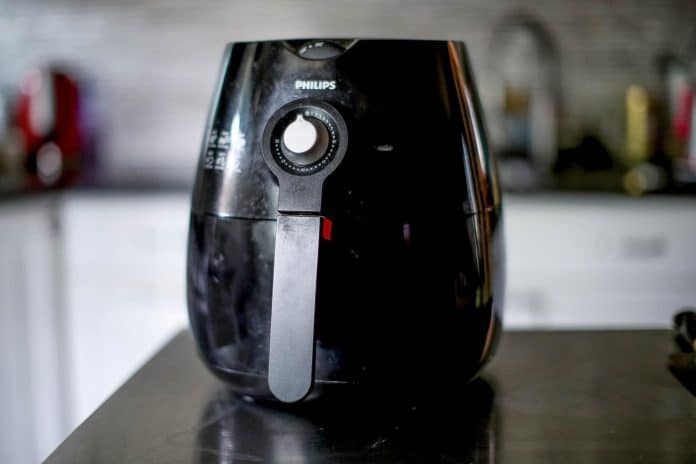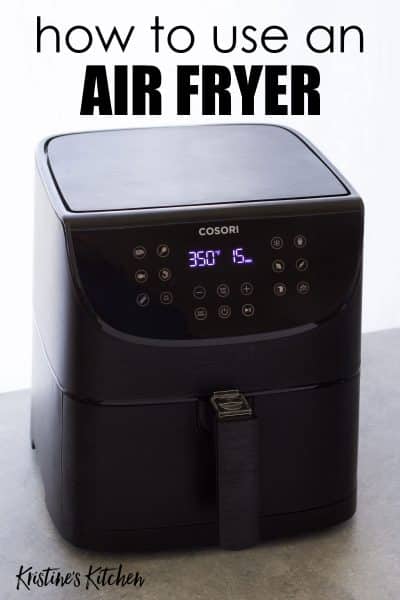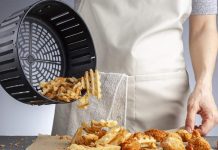So, you’ve just joined the growing number of culinary enthusiasts who have decided to invest in an air fryer. Congratulations! Now, you may be wondering, what do we do next?
Well, fear not because we’re here to guide you through those exciting first steps in owning an air fryer.
From unpacking to initial setup, we’ve covered you with our handy tips and tricks. Get ready to embark upon a delicious journey of healthier cooking options with your new kitchen companion!
This image is the property of www.simplyrecipes.com.
Unpacking and Setup
Inspecting the package
When you first receive your brand-new air fryer, it’s important to carefully inspect the package before opening it. Look for any signs of damage during shipping, such as dents, tears, or punctures. If you notice any issues, immediately contact the retailer or manufacturer for further instructions.
Checking for any damages
Once you’ve inspected the package and determined it’s in good condition, it’s time to check the air fryer for any damages. Carefully remove all packaging materials and examine the fryer for any visible dents, cracks, or scratches. If you find any damages, contact customer support for assistance.
Cleaning the air fryer
Before setting up your air fryer, please take a few moments to clean it thoroughly. Use mild dish soap and warm water to wash the removable parts, such as the cooking basket and the drip tray. Rinse and dry them thoroughly before placing them back into the air fryer. Wipe down the interior and exterior of the fryer with a damp cloth to remove any dust or debris.
Setting up the fryer
Now that your air fryer is clean, it’s time to set it up for use. Find a suitable location in your kitchen where you have enough counter space and proper ventilation (we will discuss this in more detail later). Place the air fryer on a stable, heat-resistant surface, protecting it from flammable objects or crowded countertops. Plug in the fryer, and you’re ready to move on to the next step.
Understanding the Controls
Reading the user manual
To make the most out of your new air fryer, it’s essential to read the user manual thoroughly. The manual provides valuable instructions on operating the controls, understanding the different buttons and settings, and troubleshooting in case any issues arise. Familiarize yourself with the manual to ensure you clearly understand your air fryer’s features and functionalities.
Identifying the control panel
Take a close look at the control panel of your air fryer. It will typically be located on the front of the appliance and consist of various buttons and settings. Each air fryer model may have a different control panel layout, so it’s essential to identify the specific buttons and their functions on your particular model.
Understanding different buttons and settings
Once you’ve identified the buttons on your air fryer’s control panel, it’s time to understand their functions. Familiar buttons include power, temperature control, time control, and specific cooking presets for various food items. Familiarize yourself with the functions of each button to gain confidence in using your air fryer effectively.
Getting familiar with the display
Some air fryers come equipped with a digital display screen that provides essential information and settings during cooking. Take the time to understand the meaning of different symbols or numbers that appear on the display. This will help you monitor and adjust the cooking settings accurately as you progress in your air frying journey.
This image is the property of www.simplyrecipes.com.
Choosing the Right Location
Considering the kitchen space
Before settling on a location for your air fryer, consider the space in your kitchen. Ensure enough room on your countertop to comfortably accommodate the fryer. If your kitchen is limited in space, you may need to consider alternative locations, such as a nearby table or an open cabinet shelf that provides the necessary clearance for proper airflow.
Maintaining proper ventilation
Proper ventilation is crucial when using an air fryer. Since it uses hot air to cook food, placing the fryer in an area that allows for adequate air circulation is essential. Avoid placing the air fryer in enclosed spaces or against walls that may restrict airflow. This will help prevent overheating and maintain optimal cooking performance.
Keeping away from flammable objects
As with any cooking appliance, keeping your air fryer away from flammable objects is essential. Ensure no curtains, towels, or paper products are near the fryer. This reduces the risk of accidental fires and ensures a safe cooking environment for you and your family.
Avoiding crowded countertops
When selecting a location for your air fryer, avoid crowded countertops. The fryer requires some space around it for heat dissipation and safe operation. Placing the fryer in an area with ample clearance will also make it easier to access the control panel and interact with the fryer comfortably.
Preheating the Air Fryer
Reasons to preheat
Preheating your air fryer before cooking has several advantages. Firstly, preheating helps to ensure that the fryer reaches the desired cooking temperature more quickly, reducing the cooking time. It also helps to create a crispier exterior on foods by promoting faster browning. Preheating allows the hot air to circulate more effectively, resulting in evenly cooked and delicious meals.
Adjusting the preheat temperature
Each recipe may recommend a different preheat temperature based on the specific food item. Follow the instructions in the user manual or recipe guide to adjust the preheat temperature on your air fryer. Typically, you can control the temperature using the temperature control button on the control panel. Experiment with different preheat temperatures to achieve the desired results for various recipes.
Estimated preheating times
The preheating time for your air fryer may vary depending on the model and the desired cooking temperature. On average, it takes approximately 2-5 minutes for most air fryers to reach the desired preheat temperature. However, referring to the user manual or recipe instructions is essential for more accurate preheating times related to specific recipes or food items.
Preheating tips and precautions
To ensure efficient preheating, ensure the cooking basket is inserted into the fryer during the preheat phase. This will allow the airflow to circulate correctly, preheating the basket simultaneously.
Additionally, avoid opening the fryer unnecessarily during preheating, as this can cause heat loss and result in longer preheating times. Finally, always use oven mitts or heat-resistant gloves when handling the fryer to avoid burns.
This image is the property of cdn.mos.cms.futurecdn.net.
Exploring Recipe Options
Finding recipe books
When you first buy an air fryer, you may feel overwhelmed with the possibilities of what you can cook. To start, consider purchasing air fryer recipe books that cater to this cooking method. These books often provide a wide range of recipes for different cuisines and dietary preferences, helping you unlock the full potential of your air fryer.
Browsing online recipe resources
Another great way to explore recipe options for your air fryer is to browse online recipe resources. Many websites and blogs offer a variety of air fryer recipes, ranging from appetizers and main courses to desserts and snacks. Look for trusted sources with detailed instructions and helpful tips to ensure successful cooking experiences.
Exploring air fryer-specific recipes
One of the advantages of owning an air fryer is the availability of recipes specifically designed for this cooking method. These recipes consider an air fryer’s unique characteristics and capabilities, ensuring that you achieve the best results. Look for recipes highlighting air fryer techniques, such as achieving crispy textures without deep frying or using less oil for healthier cooking.
Seeking inspiration from others
Don’t hesitate to seek inspiration from family, friends, or online communities dedicated to air frying. Sharing recipes, tips, and experiences can help expand your culinary journey and introduce you to new and exciting dishes. Whether through social media platforms or dedicated forums, engaging with others can provide knowledge and inspiration for your air-frying adventures.
Understanding Cooking Times and Temperatures
Importance of precise cooking times
Achieving perfectly cooked meals with your air fryer relies on understanding and following precise cooking times. Overcooking or undercooking can significantly impact the taste and texture of your food. Always refer to the recommended cooking times provided in the recipe or user manual to ensure that your meals turn out delicious every time.
Factors affecting cooking times
Several factors can affect the cooking times in an air fryer. The wattage of your air fryer, the size and thickness of the food item, and the desired level of doneness all play a role in determining the appropriate cooking times. It’s essential to be mindful of these factors and make necessary adjustments to achieve the desired results.
Testing cooking times for specific foods
While recipe guidelines are helpful, it’s important to remember that cooking times can vary slightly depending on personal preference and the specific air fryer model.
As you gain experience with your air fryer, don’t be afraid to conduct small cooking tests to determine the ideal cooking times for your favorite dishes. Keep notes of the adjustments you make to refer back to in the future.
Adapting recipes for the air fryer
You may come across traditional recipes not explicitly designed for an air fryer. However, many of these recipes can be adapted for air frying with a few modifications.
Consider adjusting the cooking temperature, reducing the cooking time, and using less oil in recipes that traditionally require deep frying. Experimentation is essential, so don’t be afraid to try new techniques and make adaptations to fit your air frying preferences.
This image is the property of i0.wp.com.
Choosing the Right Cooking Accessories
Assessing included accessories
When buying an air fryer, it may come with various included accessories. These accessories can enhance your cooking experience and expand your culinary possibilities. Take a moment to assess the accessories that come with your air fryer, such as cooking racks, skewers, or baking pans. Familiarize yourself with their purpose and potential uses.
Understanding their purpose
Each accessory that comes with your air fryer serves a specific purpose. For example, a cooking rack can elevate food items, allowing hot air to circulate more evenly for crispy results. Skewers can cook kebabs or small food items, while baking pans are ideal for making desserts or casseroles. Understanding the purpose of each accessory will help you utilize them effectively in your cooking.
Determining additional accessories needed
In addition to the included accessories, you may find it beneficial to purchase additional accessories to expand your air frying capabilities. Consider your cooking preferences and the types of dishes you would like to prepare. Additional air fryer accessories include grill pans, silicone cupcake liners, and pizza stones. Research the available options and choose accessories that best suit your needs.
Maintaining and cleaning accessories
To ensure optimal performance and longevity, cleaning and maintaining your air fryer accessories is essential. Most accessories are dishwasher-safe, making cleaning a breeze. However, if you prefer to hand wash them, use warm, soapy water and a gentle brush to remove any food residue. Thoroughly dry the accessories before storing them to prevent any potential corrosion.
Test Run with Basic Foods
Starting with simple foods
For your first test run with your air fryer, it’s a good idea to start with simple foods that require minimal preparation. This will allow you to familiarize yourself with the cooking process and understand how your specific air fryer performs. Consider trying out frozen French fries, chicken nuggets, or mozzarella sticks to get a feel for the cooking times and adjustments needed.
Determining the ideal cooking settings
During your test run, please pay close attention to the cooking settings you use and the results they yield. Adjust the temperature and cooking time as needed to achieve the desired level of doneness and crispiness. Take notes on the settings you find most effective for future reference.
Monitoring the cooking process
While your food is cooking, monitoring the cooking process is essential. Air frying lets you see the food as it cooks, enabling you to assess its progress and make any necessary adjustments. Use this observation time to become familiar with how your air fryer operates and to gain confidence in determining the optimal cooking times for different foods.
Analyzing the results
Once your test run is complete, take a moment to analyze the results. Assess the texture, taste, and appearance of the food you cooked. Did it turn out crispy? Was the inside cooked through?
Use this opportunity to reflect on any adjustments you made and identify improvement areas. Learning from each cooking experience will help you refine your skills and become a pro at using your air fryer.
This image is the property of www.tastingtable.com.
Maintaining and Cleaning the Air Fryer
Cleaning after each use
After each use, cleaning your air fryer thoroughly is crucial to ensure optimal performance and prevent any unpleasant odors or residue buildup. Once the air fryer has cooled down, remove the removable parts, such as the cooking basket and the drip tray.
Wash them with warm, soapy water or place them in the dishwasher if they are dishwasher-safe. Wipe down the interior of the fryer with a damp cloth and let it dry completely before reassembling it for future use.
Removing and washing removable parts
Removing and washing the removable parts of your air fryer is essential to the cleaning process. The cooking basket and drip tray, in particular, can accumulate food particles and grease during the cooking process.
To thoroughly clean these parts, use warm, soapy water and a non-abrasive sponge or brush. Rinse them well and allow them to dry completely before reinserting them into the air fryer.
Wiping down the exterior
In addition to cleaning the interior and removable parts, it’s also important to regularly wipe down the exterior of your air fryer. Use a damp cloth or sponge to remove any dust or residue that may have accumulated during the cooking process. Be sure to dry the exterior thoroughly to prevent damage to the control panel or other components.
Regular maintenance tasks
Aside from regular cleaning, you can perform a few maintenance tasks to keep your air fryer in optimal condition. Regularly inspect the power cord for any signs of damage and ensure it is properly connected.
Check the air intake and exhaust vents for any blockages or debris hindering the airflow. Use a brush or a vacuum cleaner with a soft brush attachment to remove any accumulated dust.
Troubleshooting and FAQs
Common troubleshooting tips
Even with proper usage and maintenance, you may encounter occasional issues with your air fryer. Some common troubleshooting tips include checking the power supply, ensuring the basket is inserted correctly, and verifying that the cooking time and temperature settings are correctly adjusted. If you encounter issues beyond basic troubleshooting, consult the user manual or contact customer support for further assistance.
Addressing error messages
Some air fryers have error messaging systems to alert users to potential issues. If you receive an error message on your air fryer’s display screen, consult the user manual for information on addressing the particular error code. Common error messages may indicate overheating, improper assembly, or malfunctioning components.
Understanding safety features
Air fryers are designed with various safety features to ensure secure and efficient operation. Familiarize yourself with these safety features, such as automatic shut-off mechanisms, overheating protection, and cool-touch exteriors. Understanding these features will help you use your air fryer safely and confidently.
Answering frequently asked questions.
As you embark on your air frying journey, you may have several questions that arise along the way.
Some frequently asked questions include topics such as oil usage, noise levels, and compatibility with certain types of food. Refer to the user manual or consult the manufacturer’s website for a comprehensive list of frequently asked questions and their answers.
By following these steps and tips when you first buy an air fryer, you’ll be well on your way to mastering the art of air frying.
Read the user manual, familiarize yourself with the controls, choose the right location, preheat the fryer, explore recipe options, understand cooking times, select the appropriate accessories, conduct test runs, and maintain and clean the fryer regularly. Happy air frying!









































